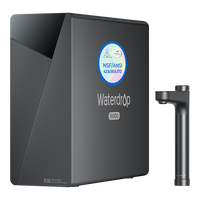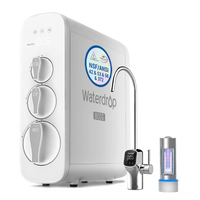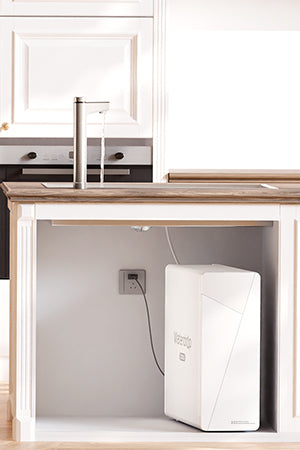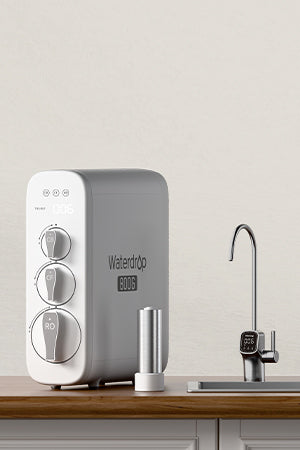What is Chloramine in Water?
The majority of the tap water supply in America has been treated by chloramine or
chlorine. Just like chlorine,
chloramine is a type of disinfectant
added in water supply to improve drinking water quality and remove the harmful components. Chloramine is used to
kill bacteria, viruses, and protozoan by breaking down their cell walls. This prevents them from causing
diseases such as diarrhea, cholera, hepatitis, and typhoid. Since bacteria, viruses, and protozoa are too small
for filters, there's no physical or chemical-free method of handling these tiny contaminants.
Why Should I Remove Chloramine from Water?
EPA has strictly regulated the amount of added chemicals. Below that limit, the
benefits of using chemical disinfectant outweighs their potential risks. Despite this, we can't ignore the so
called "insignificant" potential risks.
The major concern of chloramine in drinking water is its
effect
on human health. Chloramine will cause respiratory problems and increase asthma risks. While it may not
have significant physical effects on normal people, it causes immeasurable damage to people with respiratory
issues. Chloramine produces a vapor when it reacts with the air, which may be harmful to breathe for people with
a defective respiratory system. In most cases, when we make contact with low levels of chloramines, we feel
itchy on the skin.
Asides from the direct health effects,
chloramine also changes the
properties of water. If water supply passes through copper or lead water pipes, chloramine would trigger
the release of these harmful heavy metals into the water. Drinking this kind of water is clearly harmful to the
body. What's more; chloramine can deteriorate rubber and plastic, and corrode metal. These two components are
found in all our faucets, shower heads, toilet valves and other in-house appliances and fixtures.
Although it's allegedly safe to drink water that contains no more than 4 milligrams
of chloramine per liter, everyone would avoid contact with chloramine of any amount considering the possible
health risks involved.
How to Remove Chloramine from Water?
Activated carbon filtration
There are various ways of removing chloramine from water. Carbon filtration is an
effective way to absorb the various contaminants in water, including chloramine. You can learn more about
activated carbon filtration in this blog:
All You
Need To Know About Activated Carbon For Water Filtration. Chloramine in water is absorbed when water
passes through the filter, sticking to the surface of the filter media. The larger the carbon contact surface in
the filter, the better the filtration performance. However, over time, contaminants may block the pores on the
filter media, leading to poor water flow and degraded filtration performance. Changing the filter according to
the service life quoted by the manufacturer will fix this problem.
Standard activated carbon filter isn't effective enough to reduce chloramine. This
is because it requires a longer contact period to achieve any significant reduction in chloramine. But this
under-sink water filter system with dual carbon perfectly fixes this problem. The large volume of carbon content
is responsible for the enlarged contact surface with chloramine.
Reverse osmosis
The reverse osmosis filtration is a high-tech water treatment, considered to be the
most effective water filtration technology out there. It features 0.0001-micron pore size, intercepting any
contaminants larger than that size. This means that only water particles can pass through the RO membrane. It's
thorough not only for chloramine, but for eliminating several other common contaminants. Learn more features
about reverse osmosiss filtration here:
What Is a Reverse
Osmosis System and How Does It Work.
Ultra-filtration system
The ultra-filtration water filter system is also efficient at chloramine reduction.
It depends on 0.01-micron ultra-filtration membrane to intercept most contaminants. The ultra-filtration filter
combines with the activated carbon filter to deliver a double protection system that ensures excellent
chloramine reduction. While its filtration accuracy is not as good as RO membrane, an ultra-filtration water
filter is an affordable and effective alternative to remove chloramine from water. This blog explains how does
ultra-filtration work in details:
What Is
Ultrafiltration Membrane And How Does It Work?
Frequently Asked Questions
Does Boiling Water Remove Chloramine?
Yes, but partially. You could remove chloramine by boiling water. However, the
problem is that the chloramine can't be removed completely. During the boiling process, it would release
chloramine gas into air continuously, increasing the amount of time required until the last volume of chloramine
is converted to gas. Therefore, it's easier and more effective to install a water filter to remove chloramine
than boiling the water.
Will chloramine evaporate from water?
Unlike chlorine, chloramine will not evaporate from water. Chloramine is much
stronger than chlorine and it takes longer to react. This is why you need a powerful filter, specifically
created to remove chloramine from drinking or showering water.
Summary
Chloramine is a dangerous component of public water that many people tend to
ignore. The exposure of the skin to chloramine causes skin allergy and respiratory issues. Considering how
powerful it is, only the right filter can effectively and completely remove it from water. So, don't hesitate to
install a water filter. Nothing is more important than protecting your health.






































































